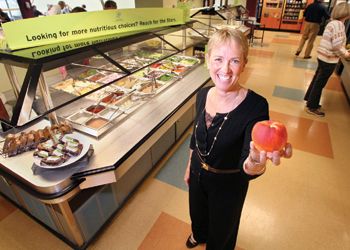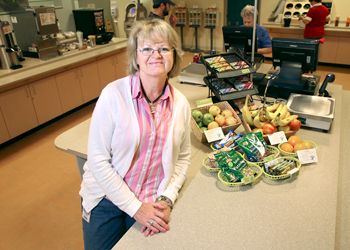Processing Your Payment
Please do not leave this page until complete. This can take a few moments.
- News
-
Editions
View Digital Editions
Biweekly Issues
- December 1, 2025
- Nov. 17, 2025
- November 03, 2025
- October 20, 2025
- October 6, 2025
- September 22, 2025
- + More
Special Editions
- Lists
- Viewpoints
-
Our Events
Event Info
Award Honorees
- Calendar
- Biz Marketplace
Hannaford's patented Guiding Stars nutritional rating system jumps from grocery aisles to corporate cafeterias
 Photo/Tim Greenway
Betts FitzGerald oversees Hannaford's Guiding Stars nutritional ratings program
Photo/Tim Greenway
Betts FitzGerald oversees Hannaford's Guiding Stars nutritional ratings program
 Photo/Tim Greenway
Kim Cassella, cafeteria services manager at Idexx, says the company preferred Guiding Stars to a registered dietician due to its ease of use
Photo/Tim Greenway
Kim Cassella, cafeteria services manager at Idexx, says the company preferred Guiding Stars to a registered dietician due to its ease of use
Betts FitzGerald, a managing director at Hannaford Bros. Co., has Muppet posters in her office at the company's headquarters in Scarborough. In one of them, Kermit the Frog is dressed up to look like a sexy Marky Mark in one of the rapper's iconic Calvin Klein advertisements. Kermit's wearing low-slung jeans exposing his tighty-whities and scrawny green chest. He might be trying to look alluring but his expression is standard Kermit — slightly self-abashed and puzzled. The other poster shows Miss Piggy mimicking a sultry Claudia Schiffer. She pulls it off well, if you can overlook her snout.
The black-and-white framed posters in FitzGerald's otherwise ordinary corporate office are a reminder that, in a funny way, the Muppets are helping people eat better. FitzGerald worked at the Jim Henson Co. in New York City for 26 years in the licensing department, and then brought her expertise to Maine when she started working for Hannaford's nutritional rating system, Guiding Stars, in 2008.
"I took what I learned there to this job," FitzGerald says, at an interview in her office. She speaks crisply, at a fast tempo, possibly a hold-over from her NYC days. Her demeanor is warm and she exudes a glow of good health. "And I feel equally passionate about this position. I love to eat, I love real food, I love good food. I'm grateful to be in a position with Guiding Stars where I can move the needle a bit."
Since Guiding Stars began in 2006, it has expanded beyond the grocery store aisle for which it was originally intended. Somewhat to Hannaford's surprise, the system has been picked up by schools, colleges, hospitals and corporate cafeterias. FitzGerald was hired to continue Guiding Stars' trajectory into new businesses and markets. "Supermarkets are the tip of the iceberg," FitzGerald says.
The guiding system, which uses a three-star rating to assess the nutritional value of food, is now in more than 1,600 grocery stores around the country, and in the cafeterias of Bates College, MaineGeneral Medical Center, Idexx and the University of New Hampshire, to name a few. This summer, Guiding Stars was granted a patent for its food-rating algorithm. The 13-person team at Guiding Stars expects to keep expanding the program as more people crave a healthier diet and life. Anywhere consumers are confronted with a choice about food could be a platform and potential market for Guiding Stars, from restaurants to vending machines.
But could the nutritional guiding system become irrelevant as people become more food savvy and health conscious? Unlikely, FitzGerald says. "For a lot of people, it's like a foreign language," she says, referring to health-food lingo. "They say, 'Bacon is bacon. How can it be bad?' And it's not bad, but if you ate it seven days a week it's bad."
And as long as food producers keep making yogurts with lots of sugar, marinara sauces with lots of sodium and whole-wheat crackers with a high fat content, there will be a need for nutritional guiding systems to help consumers navigate the array of food options, FitzGerald points out.
The arc of Guiding Stars
Hannaford created Guiding Stars in 2006 after research showed its customers were struggling to discern the healthy food from the junk. While most food carries nutritional labeling according to U.S. Food and Drug Administration requirements, not everyone understands what riboflavin is or how much sodium is bad for you. Hannaford consulted with nutritionists and food scientists to analyze its inventory, giving the most nutritious products three stars and the least nutritious no stars. (See "How Guiding Stars works," this page.)
Back when Hannaford formed Guiding Stars, it did so to increase customer loyalty. But once it became obvious the program could grow beyond the grocery store, Hannaford spun it off into the company's first business-to-business subsidiary, led by a team of licensing experts, according to Hannaford spokesman Michael Norton.
While Hannaford came early to the nutrition-scoring game, Guiding Stars is not the sole player in the market: Its closest competitor is perhaps NuVal, based in Massachusetts, which rates foods from 1 to 100. No food in this system goes unrated, unlike Guiding Stars, which leaves a lot of "bad" food unmarked. Due to these differences, there's some argument in the nutrition world about which scale makes more sense and works better.
NuVal spokesman Robert Keane says, "Our measurement system is more robust and gives you a better degree of how foods compare to others. If you have something that is 100 points, you're going to get a more accurate read of the food than a system with four points."
But FitzGerald says the simplicity of Guiding Stars is one of its best assets. "The reality is the world is a complex place," she says. But, "we live in a world of sound bites and we want easy answers. Guiding Stars takes complex information and simplifies it down. It doesn't matter if it's an adult, teenager or baby boomer, they'll understand and make better choices in the aisle or food service area."
Michael Jacobson leads the Center for Science in the Public Interest in Washington, D.C., a nonprofit watchdog that advocates for better nutrition and food safety policies. He says both NuVal and Guiding Stars are sensible and represent a laudable move in the "direction of providing consumers with simplified systems." Of Guiding Stars in particular, he says, "It's easy for consumers to understand and it gives food processors an incentive to get one more star, at least."
But Jacobson says not enough independent research has been done to compare the two systems or to measure them against other nutritional guides like Healthy Ideas or nutrition iQ, Shaw's system. (See "Shaw's takes a different route," this page.) "The question is which is most effective at moving companies and people to healthier foods," he says.
A 2010 report by Guiding Stars' scientific advisers in the American Journal of Clinical Nutrition found that consumers purchased 1.39% more food products carrying stars two years after the program was implemented, which translates to roughly 2.9 million more starred items purchased per month. While that's a positive bump, it doesn't speak to an "overwhelming movement," Jacobson says.
Aside from its marketing results, Guiding Stars serves as an effective branding tool for Hannaford and the other grocery stores under parent company Delhaize Group, including Food Lion and Sweetbay supermarkets. "Guiding Stars is a loyalty engine for Hannaford," Norton writes in an email. "More than 80% of our customers know about the program, and a significant share of those customers use the program occasionally or frequently. It's challenging to acquire new customers so we're pleased to have Guiding Stars as a tool to keep shoppers with Hannaford."
Businesses adopt the stars
Cafeterias that adopt Guiding Stars submit every recipe and product they sell to Guiding Stars' data team, which analyzes this information using its algorithmic formula and then assigns a star rating. The process can take a couple of months. Idexx began consulting with Guiding Stars last February and launched its new dining program in May at its Westbrook headquarters, which has 1,500 employees. Since then, sales of whole milk and 2% milk in the cafeteria have fallen by 31.6%, while sales of skim milk and 1% milk have increased by 50.3%, according to Idexx's cafeteria services manager, Kim Cassella. And oatmeal sales have shot through the roof, increasing by 438.2%, she says.
Cassella says Idexx chose Guiding Stars rather than a registered dietician because it offers an easy system. "There's a diverse population at Idexx," Cassella says, including PhD scientists and employees who don't speak English as a first language. "I needed a program that would support all walks of life." In the future, Cassella says she would like to implement an incentive program for workers who consistently choose starred foods.
Topsham area school district MSAD 75, which includes Mt. Ararat middle and high schools, was Guiding Stars' first school pilot program and consequently pays no fees, according to Mary Booth, the district's health coordinator. After the first year, the school cafeterias saw a 10% to 15% increase in skim milk consumption, Booth says. "If you're trying to get through a line with a lot of students as quickly as possible … Guiding Stars helps students see what is most nutrition-dense quickly," she explains.
Bates College, the first college to implement Guiding Stars in 2009, selected the program because it doesn't focus on calories or fat content, according to dining services director Christine Schwartz. "Studies show that that tends to increase the likelihood of eating disorders, especially in the population we're dealing with," she says. "We were looking for a way to provide nutritional info without providing that level of detail." The school pays an annual licensing fee of roughly $5,000 on top of a per-recipe fee, she says.
And this summer MaineGeneral Medical Center put Guiding Stars into three of its cafeterias in Augusta and Waterville. "As a health care organization, we're taking positive steps to help employees and visitors to be healthier while helping keep health care costs down," spokeswoman Sarah Webster says. "It's the right thing to do."
Looking to the future, FitzGerald says Guiding Stars will continue to expand its "brick and mortar" partners, as she calls them — the cafeterias and retail grocers — while also exploring more online offerings. It's already built a mobile "Shopper" app, and has an online Food Finder tool that lets users search for star ratings for different foods.
FitzGerald says she sees her job as providing a service that can direct people to healthier choices. She herself is an avid restaurant-goer and summertime griller, she says. "I love food," she explains. "I love being able to give people a chance to eat better. Why not go through life enjoying the good stuff?"
Rebecca Goldfine, Mainebiz staff writer, can be reached at rgoldfine@mainebiz.biz.
How Guiding Stars works
Mainebiz web partners
Related Content

The Giving Guide
The Giving Guide helps nonprofits have the opportunity to showcase and differentiate their organizations so that businesses better understand how they can contribute to a nonprofit’s mission and work.
Learn More
Work for ME
Work for ME is a workforce development tool to help Maine’s employers target Maine’s emerging workforce. Work for ME highlights each industry, its impact on Maine’s economy, the jobs available to entry-level workers, the training and education needed to get a career started.
Learn More
Groundbreaking Maine
Whether you’re a developer, financer, architect, or industry enthusiast, Groundbreaking Maine is crafted to be your go-to source for valuable insights in Maine’s real estate and construction community.
Learn more-
The Giving Guide
The Giving Guide helps nonprofits have the opportunity to showcase and differentiate their organizations so that businesses better understand how they can contribute to a nonprofit’s mission and work.
-
Work for ME
Work for ME is a workforce development tool to help Maine’s employers target Maine’s emerging workforce. Work for ME highlights each industry, its impact on Maine’s economy, the jobs available to entry-level workers, the training and education needed to get a career started.
-
Groundbreaking Maine
Whether you’re a developer, financer, architect, or industry enthusiast, Groundbreaking Maine is crafted to be your go-to source for valuable insights in Maine’s real estate and construction community.
ABOUT
NEW ENGLAND BUSINESS MEDIA SITES
No articles left
Get access now
In order to use this feature, we need some information from you. You can also login or register for a free account.
By clicking submit you are agreeing to our cookie usage and Privacy Policy
Already have an account? Login
Already have an account? Login
Want to create an account? Register
Get access now
In order to use this feature, we need some information from you. You can also login or register for a free account.
By clicking submit you are agreeing to our cookie usage and Privacy Policy
Already have an account? Login
Already have an account? Login
Want to create an account? Register











Comments